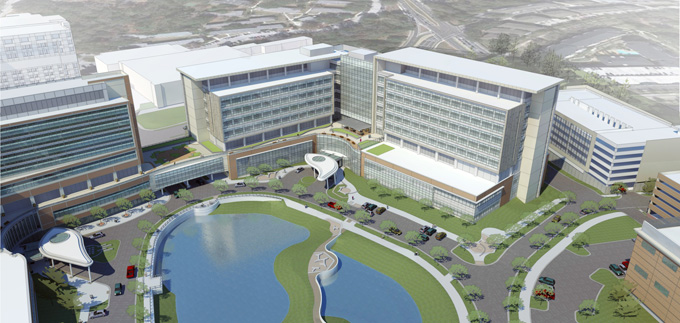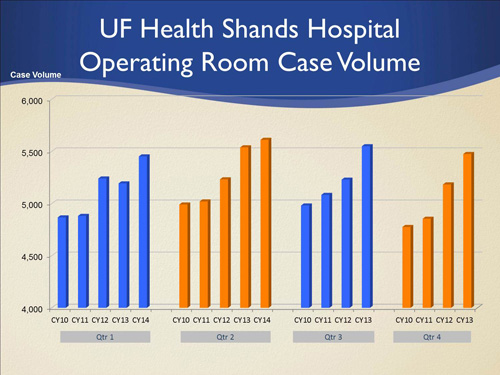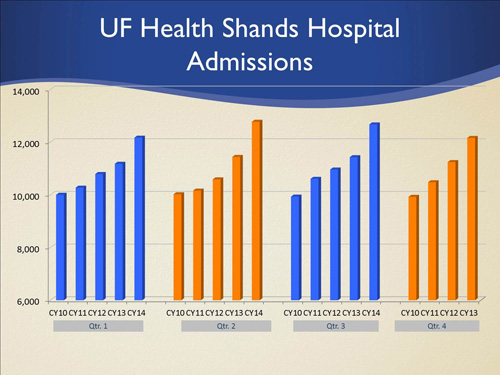Caring for Florida’s Hearts and Minds
We’re growing. The future is bright for continued growth. But we’re out of space. So … we’re building a new hospital. Actually, two hospitals – one for heart & vascular care and one for neuromedicine – connected to each other and to the Cancer Hospital.
 You may have read or heard about this new building project and were wondering about the back story. That’s the topic of this issue of OTSP.
You may have read or heard about this new building project and were wondering about the back story. That’s the topic of this issue of OTSP.
(Note: this newsletter pertains to the Gainesville campus. A major building project is also occurring in Jacksonville, motivated by different factors; this will be the subject of a future newsletter.)
The news media and our professional publications are replete with stories about current and future changes in health care nationally that are impacting academic health centers (AHCs): a shift from inpatient to outpatient care; the rise of managed care insurance plans containing “narrow networks” of physicians and hospitals that exclude AHCs as “too expensive;” downward pressure on reimbursement from Medicaid and Medicare; the shift to high-deductible health plans that put more financial burden on patients and reduce their demand for services; reduced payments to AHCs for Graduate Medical Education; and on and on. This has led many community hospitals and academic health centers to abandon thoughts of expansion; rather, many such institutions are hunkering down with the facilities they currently have available.
In view of these well-publicized trends, the decision by the UF Health Shands Board of Directors on September 26, 2014 to proceed with new construction of two hospitals that will contain a total of 216 new beds (including 72 ICU beds) and 20 new operating rooms may seem out-of-step and even risky. Rest assured that this decision was made only after careful and exhaustive review of all of the available data, taking into account data on both external forces and local performance, and mindful of the vision of our health system and University.
Let’s look at the vision and the data. The vision in our strategic plan, Forward Together, is to create unstoppable momentum towards achieving our patient-care, education and research goals. Our goal is to become recognized as the best academic health center in the Southeast. Achieving this vision begins with a robust health system, which serves as an economic engine that drives the academic missions, which in turn feeds back to the health system in a positive loop. The data on our academic health center indicate that we have indeed been successful in iteratively expanding this virtuous circle. Because of the tremendous efforts of faculty and staff in embracing the principles set forth in Forward Together, the annual number of patients seen by our faculty has increased 30 percent in the past four years, and the number of admissions to UF Health Shands has increased by 28 percent during that period. This growth has led to increased hospital financial margins that have been invested back in the academic enterprise, contributing to a 35% increase in NIH funding over the past 4 years at the Health Science Center, despite a flat NIH budget nationally (and this is before the UF preeminence program).
The new building project is hospital-based, although there will be faculty practice offices for both cardiovascular services and neuromedicine services on the first floor of the respective hospital towers. Shown below are bar graphs depicting seasonally adjusted growth in the number of surgical cases and hospital admissions to UF Health Shands.


Back at the beginning of 2013, we realized that, if we were to maintain our growth trajectory, we would not have sufficient capacity at UF Health Shands. Some capacity can be created by reducing length of stay (LOS). Indeed, reductions in LOS at UF Health Shands over the past few years have created the equivalent of 28 additional beds. But there is a limit to which LOS can be reduced when the goal is provide the best quality of care and to keep readmissions to a minimum, especially since the medical complexity of our patients has also been increasing. Moreover, besides capacity limits, there were other reasons to consider building a new hospital. An important consideration is to convert many of the semiprivate rooms that still exist at UF Health Shands to private rooms. Another is to align clinical programs with clinical facilities – i.e., creating geo-centralization as we have for cancer, orthopedic, women’s and children’s services. Many of our ICUs, especially cardiovascular ICUs, are “vintage” facilities that are inconsistent with our vision. And finally, many contemporary innovations in surgical care, including hybrid operating rooms for cardiovascular surgery and intraoperative MRI capabilities for neurosurgery, cannot easily be accommodated by renovating existing ORs.
In view of these considerations, a special retreat of the UF Health Shands board, devoted specifically to the issue of building a new hospital, was held April 12-13, 2013. Our initial plan was to evaluate the addition of a hospital tower for either cardiovascular or neuromedicine services onto the existing Cancer Hospital, which was designed to accommodate such an addition, and to renovate vacated space for the other service. Considerable data were presented, and faculty from cardiology, cardiothoracic surgery, vascular surgery, neurology and neurosurgery presented information on the current and future directions of their fields, the challenges facing their clinical practice in our current facilities, and what would be needed in new or renovated space. When all was said and done, the board concluded that building one new hospital tower with back-fill renovations would not solve the problems of converting semiprivate to private rooms, the need for geo-centralization, or creating sufficient space to accommodate projected growth, and that such a plan would not achieve the vision of being the best academic health center in the Southeast. Board members therefore asked UF Health leadership to explore the possibility of building two hospital towers sharing common infrastructure, one for heart & vascular care and one for neuromedicine.
During the spring and summer of 2013 we met with faculty members and staff to consider a variety of options and their clinical, operational and financial implications. At the UF Health Shands board meeting on September 25, 2013, our findings were presented and the board approved $20 million for a year-long process in which plans for the two hospitals would be designed along with plans for renovation of existing space to create geo-localization. We would also have one more year to track the trajectory of our clinical services and financial results, and time to analyze the projections of clinical and financial data over a 10-year time horizon.
A design oversight committee was convened, consisting of chairs and chiefs of the relevant departments and divisions, and UF Health leadership:
- Tetsuo Ashizawa, MD
- Thomas Beaver, MD
- Kevin Behrns, MD
- Jamie Conti, MD
- Tim Flynn, MD
- Bill Friedman, MD
- Tim Goldfarb, MHA
- Michael Good, MD
- David Guzick, MD, PhD
- Rob Hromas, MD
- Thomas Huber, MD, PhD
- Ed Jimenez, MBA
- Dick Lister, MD
- Brad Pollitt, MA, AIA
- Bill Robinson, MBA
Flad Architects (www.flad.com), with a team based out of their headquarters in Madison, Wisconsin, was chosen to work with us to design the hospitals. In the fall of 2013, teams of architects and faculty visited recently completed facilities at Massachusetts General Hospital, Brigham and Women’s Hospital, University of Michigan, and Cedars-Sinai Medical Center. Throughout the year, the Flad team spent a week each month on campus, meeting not only with the design committee to assess program needs, but with a myriad of user groups in all areas that intersect with clinical services. The goal was to create spaces for heart & vascular care and neuromedicine that would facilitate the “perfect patient experience.” The design of the new hospitals, both inside and out, took shape.
Some of the key considerations that were incorporated into the design include:
- Outpatient (faculty practice) and inpatient services integrated in one location
- All private rooms that accentuate light, comfort, and space for family in a patient-controlled environment
- Comfortable and inviting family lounges on each floor
- ICU rooms and general medical-surgical rooms of the same size, to provide future flexibility in converting one to the other
- Convenient access to imaging for all inpatients
- State-of-the-art operating rooms and cath labs.
- A bridge on the second floor to the Cancer Hospital (over Circle of Hope Drive) containing a post-op unit that can serve the operating rooms of both hospitals to promote quality and efficiency
- External design that borrows significantly from the design of the Cancer Hospital, but projects a somewhat more contemporary appearance, consistent with the forward-looking nature of our heart & vascular and neuromedicine services
This is an exciting project. The growth in demand for our services, which has created this need for new space, reflects the collective efforts of our faculty and staff over the past several years. It isn’t just one service and it isn’t just one aspect of clinical service: it’s the success we’ve achieved across all services in all of the issues we have been tackling each day: quality and safety; access; hospitality and service; teamwork; reaching for and attaining excellence; alignment of clinical programs and facilities; efficient processes; “we and they” becoming “us.” While more work remains in each of these areas, we can be proud of our achievements to date.
Moreover, building the new hospitals not only improves our ability to provide the perfect patient experience for cardiovascular and neuromedicine patients, but frees up space in the main hospital (“North Tower”) that can be used to convert semiprivate to private rooms, complete the children’s hospital and the upgrading of women’s services, and geo-centralize medical and other clinical services.
No doubt, there is some risk in proceeding with this large building project if the external forces at work in health care listed in the first paragraph impact us more than anticipated. The construction cost is $415 million, to be paid by a combination of hospital reserves, borrowing and philanthropy. A fundraising campaign, which is just getting off the ground, will be critical. If revenues are compromised by external factors, and/or if philanthropy falls short of projections, there is a risk that paying for the new hospitals across time in the face of constrained revenues will compromise our other missions.
The hospital board concluded, however, that the risk of not building the two new hospitals is greater than the risk of proceeding. Over the next 5-10 years, it will become increasingly difficult if not impossible to provide the perfect patient experience, and to achieve our goal of becoming the best academic health center in the Southeast, if we cap growth and continue with a vintage, cramped hospital containing large numbers of semiprivate rooms. In serving the state and the missions of the University of Florida, it is better to continue to grow, to recruit and retain the very best faculty, and to create an environment in which the very best patient care supports our education and research goals.
Preliminary work on the project is now proceeding and a shovel will be in the ground in January. We look forward to seeing you at the groundbreaking!
Forward Together,
David S. Guzick, M.D., Ph.D. Senior Vice President for Health Affairs President, UF Health University of Florida
About the author
